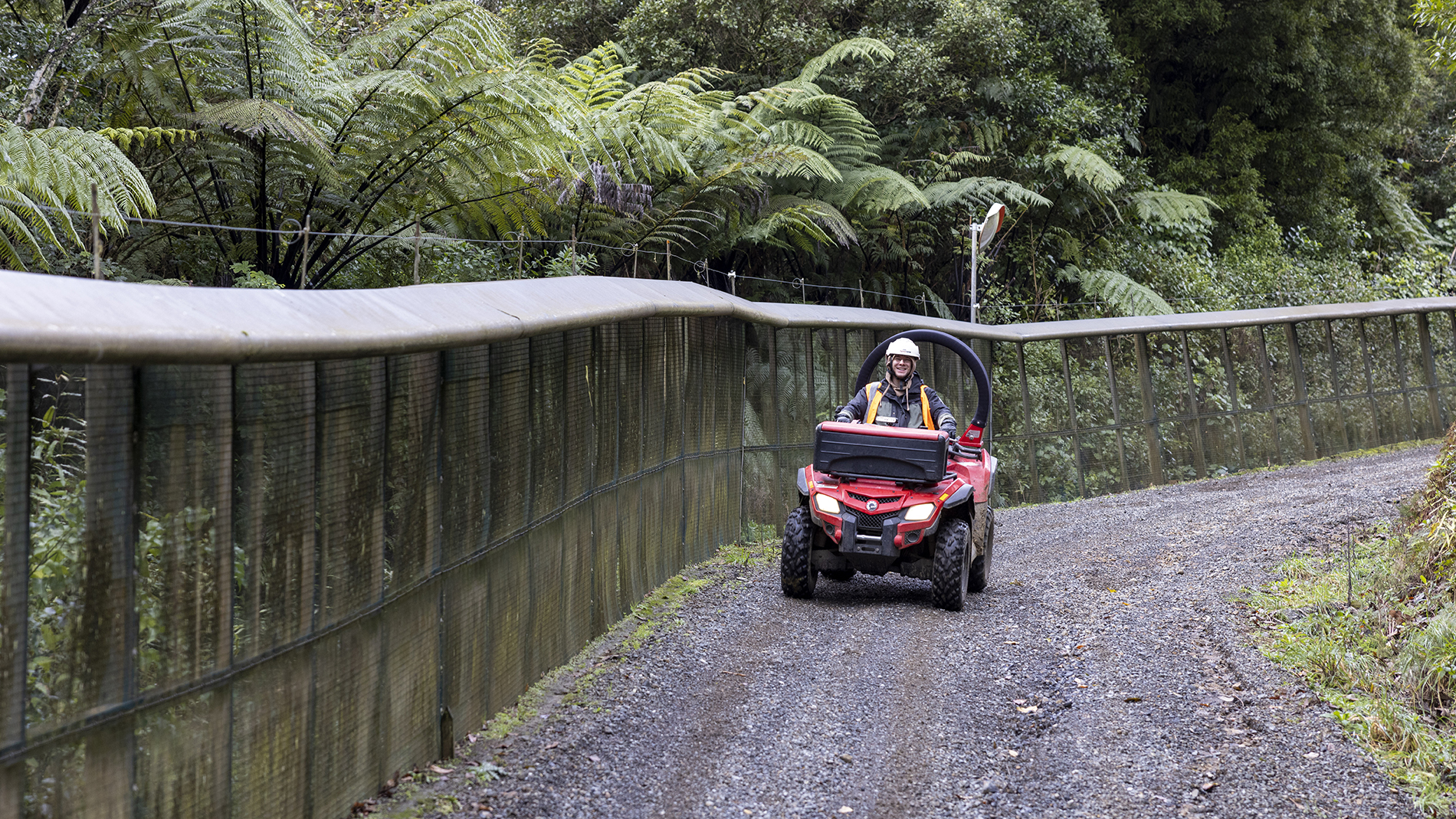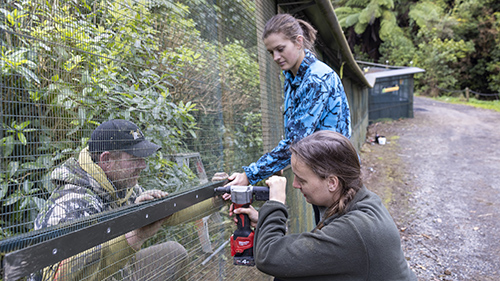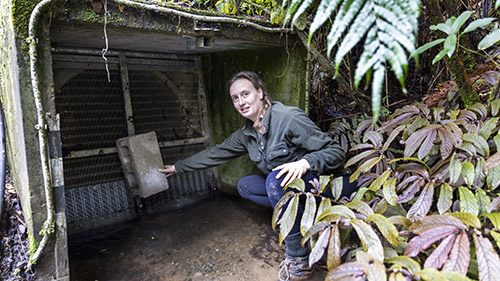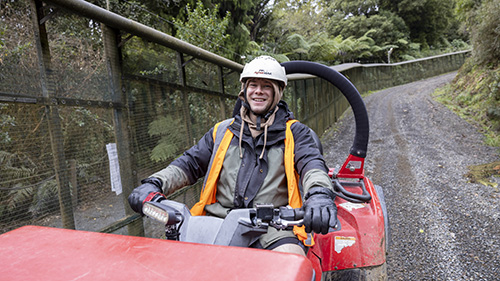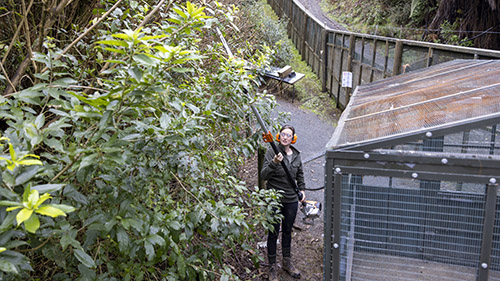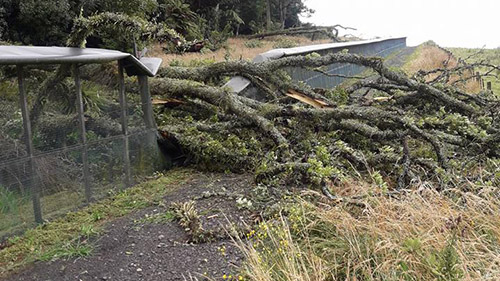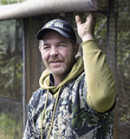 “Ponga fronds are the worst offender. But we’ve also had wētā and stick insects set off the alert, and bird strike.”
“Ponga fronds are the worst offender. But we’ve also had wētā and stick insects set off the alert, and bird strike.”
- James Matthews, Asset and Operations Team Leader
Winter is always coming to Sanctuary Mountain Maungatautari.
For those on watch at the inland ecological island, that means always being prepared for a breach of its 47-kilometre-long fortification, the only barrier between the native species inside and the predators beyond.
Asset and operations team leader James Matthews says successfully defending the mountain requires ongoing maintenance of the predator fence, being able to respond 24/7 to any threats of integrity and the quick removal of any invader species should a breach occur.
James, who has been on the job for 13 years, says the worst night he can remember was when 10 trees came crashing through the fence.
On average, there are over 110 fence breach alerts annually, with breaches categorised from no damage and no chance of pest incursion through to catastrophic damage and a high chance of pest incursion.
Staff are on-call 24/7 365 days a year to attend to these breaches.
“Night or day, rain or shine, we have 90 minutes in which to respond,” says James. That time is based on a study which estimated typical times for a pest incursion to occur.
The fence has a surveillance wire running across the top of it. If anything sits on the wire for more than three minutes then an alert with the location – give or take a kilometre – is sent via text message.
“The pests are active at night, too, you can see them in your headlights, running alongside the fence trying to find ways to get in.”
And, of course, the weather is usually atrocious.
Sanctuary Mountain® Maungatautari, south of Cambridge, is a haven for some of New Zealand’s most endangered species. Many of these species have been reintroduced to the maunga since the predator fence was completed in 2006 and mammalian pests (except for mice) eradicated.
Bird species reintroduced to the maunga include North Island brown kiwi, takahē, North Island kākā, titipounamu (rifleman), pōpokotea (whitehead), hihi (stitchbird), pitoitoi (North Island robin), North Island kōkakō and tīeke (North Island saddleback). Non-bird species reintroduced include Mahoenui giant wētā, tuatara, banded kōkopu and giant kōkopu.
The flightless kākāpō, which is currently found only on offshore predator-free islands, is the next endangered species potentially heading for the 3363-hectare mainland sanctuary. It is hoped the kākāpō translocation will occur in 2023, but first the inside of the fence must be kākāpō proofed. This involves fixing the inside of the fence with a sheet metal band to prevent the large, nocturnal parrot from climbing out. The maunga will act as a refuge for the growing kākāpō population and be a test site for kākāpō breeding behaviour in the absence of a rimu dominated forest.
Such projects are only possible because of the maunga’s predator free status. Maintaining a pest-free mountain is a huge and ongoing task that Maungatautari Ecological Island Trust must raise more than $1.6 million a year to achieve.
The trust has been a significant beneficiary of Waikato Regional Council’s Natural Heritage Fund in the past 14 years, with the most recent grant ($1.48 million over four years) approved in June 2022 to help cover the cost of maintaining the fence and towards detecting and removing invasive species.
At the moment, James and his team, currently bolstered by four Jobs for Nature rangers, are upgrading parts of the ageing fence infrastructure, replacing old wooden batons with aluminium joinery, and adding a post between fence sections.
Another important piece of work is vegetation control – keeping the forest one metre back from the fence to reduce the number of fence breaches.
“We’re going to end up with the biggest, thickest native tree hedge in the world,” says James.
Once a year, a tractor with an arm mower is used to reach over the fence and cut back the encroaching branches and understorey, which is also thriving. Pole saws and loppers are used at other times to keep back any offending branches.
“Ponga fronds are the worst offender,” says James. “But we’ve also had wētā and stick insects set off the alert, and bird strike.”
All alerts must be checked. If it turns out a tree has gone through the fence, then a temporary fence is installed to prevent an incursion of pest species until the fence is fully repaired. To be safe, six weeks of intensive predator control and monitoring are also carried out at the location of the breach.
There are 42 streams running down the mountain which are channelled under the fence through specially designed culverts or water gates. The water gates, which are also alarmed to let staff know when they open, are “the weakest part of the fence”. They get checked regularly to ensure they have not been jammed open by debris washed downstream.
The one-metre-wide corridor between the fence and the bush is kept weed free. This helps during fence inspections to detect any new holes that pest species can get through. It also helps staff navigate the 776 tracking tunnels and 406 DOC traps placed along the inside of the fence line.
The smooth fence hood grows a lot of lichen and moss. “We water blast it a lot. Lichen gives traction for pest species.” The pieces that make up the hood are riveted together, and the fence is always shifting. Every new nook and cranny that could possibly help a predator species get in must be fixed.
Fixing the access track around the outside of the fence is a big yearly job. “The track gets quite hairy in winter. A lot of our funding goes into metal,” says James. “We have our own machinery, and spreading metal is what we do every summer. We have to maintain landowners’ tracks, too. There are 22 landowners that we actively deal with on a regular basis for access to the fence.”
The fence runs on solar power. “In summer that is fine,” says James. “But in winter, it’s overcast, rainy up here, and the batteries don’t charge well. We spend quite a bit of time on charging batteries and changing batteries to prevent the fence from turning off.
“Our staff and volunteers put in the mahi, they are doing the hard yards for conservation in the long run,” says James. “And they are out there in all weather, rain or shine.”



